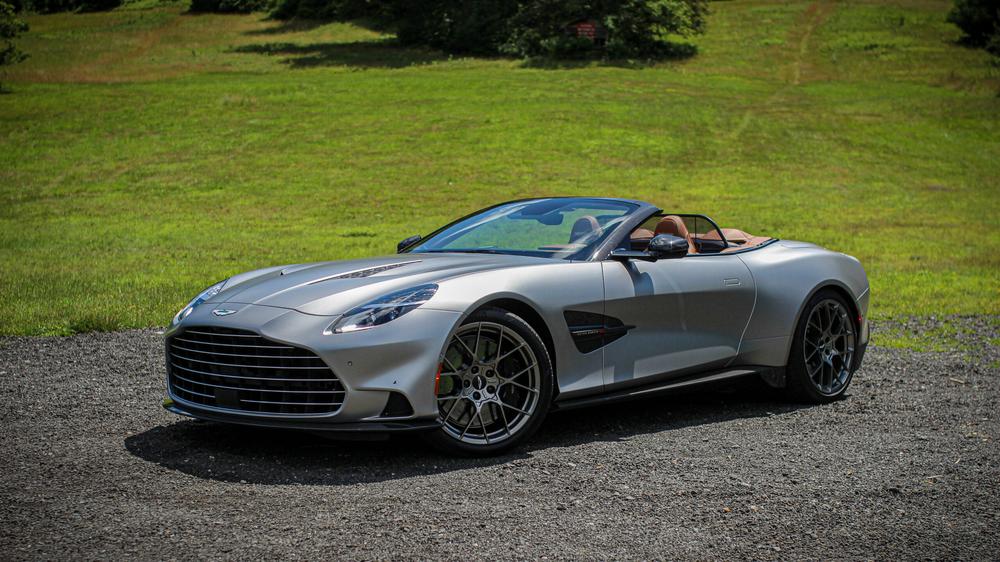We live in the era of the electric car—lightning that can't be put back in its bottle. This is important to keep in mind when we talk about new cars like the Aston Martin Vanquish Volante, because on paper, it seems hard to justify its half-million-dollar price tag and 800-plus horsepower twin-turbo V12 when things like Rivian's Quad-motor R1 vehicles and Lucid's Air can top its numbers for half the price. I say this not to suck the air out of the room but to put things in perspective, as this was on my mind when I slid into the driver's seat of Aston's latest ultra-luxury option.
What I was quickly reminded of, however, is that this is decadence, which, by its nature, does not need to be justified. Nobody needs an Aston Martin; you want one. You don't simply drive it, either; you indulge in it.
Layer cake
Aston Martin's current state of affairs is a strong one. Thanks to the efforts of Executive Chairman Lawrence Stroll course-correcting the wayward ship of Aston Martin Lagonda—nobody remembers the Lagonda part, not even AML—the brand's portfolio contains four core vehicles, with several derivatives like the Vantage S on their way. This also includes the Volante, or convertible versions, such as this one, which is the fastest and most powerful mainline Aston Martin convertible ever made.
Like its coupe counterpart, the Vanquish Volante is powered by a fully redesigned twin-turbo 5.2 L V12 that generates 823 hp (614 kW) and 738 lb-ft (1,000 Nm) of torque. Power is sent to the rear by way of an 8-speed automatic, allowing this bougie baddie to sprint from 0 to 62 mph (100 km/h) in 3.4 seconds on the way to its 214 mph (345 km/h) top speed.
Unlike the coupe, the top comes off and tucks neatly away beneath a nearly seamless decklid that doesn't interfere with the sharp overall packaging. Beyond this, the differences between the two versions are negligible, with a slight tweak in rear-end stiffness. Aston Martin was deliberate in saying the Volante was not "detuned" in any way due to the loss of a fixed roof. In keeping with the car's speedy nature, the top drops in a mere 14 seconds and can be replaced in 16 once you've had enough of onlookers broadcasting the ways they'd defile the car if it were in their charge instead.
It's hard to blame them. Top up or down, the Vanquish's aesthetic is one of eagerness and aggression, largely due to the F1-derived aero elements to cool the massive power unit as well as to balance out air from front to back. The rest is all Aston Martin-quality craftsmanship, shaping the Vanquish into a taut, sleek form wrapped in formal attire.
Bond. Aluminum Bond.
The secret underlying the Vanquish's capabilities is its bonded aluminum body, which is perfectly suited for a grand tourer like this. Bonding panels together rather than welding them makes controlling the NVH (noise, vibration, harshness) levels much easier as the adhesives absorb vibrations, while the stiffness provides much more control in terms of lateral movement. This also means the suspension has less to compensate for, which means it can be stiffer without adding teeth-rattling jitter.
Indeed, on the move, the Vanquish Volante is velvety-smooth on the highway, and with the top down, conversations don't need to be shouted. Raise the soft top and the well-sealed cover is indistinguishable from the coupe as far as your ears are concerned.
The even-keeled nature is also due in part to the balance Aston Martin maintains between the throttle input and the electronic rear differential. At low speeds, the Vanquish is quite agile, but a progressive power band keeps it from being nervous or jerky when laying down the power, with the wheels effectively locked in place at high speeds for added stability.
We're talking autobahn speeds, here, by the way. What we'd usually muster on the highway is a cakewalk for this immense luxury chariot. It goes too fast too quickly, for better or for worse, with 80 mph (129 km/h) feeling like half of that. Different drive modes make a palpable difference in behavior, with GT mode supporting smooth, long stretches while Sport and Sport + offer more engaging, throaty behavior for twisty backroads. Here, the car continues to be well-mannered, though the occasional dab for power triggers an overeager automatic into dropping a gear or two, sending the V12 into a fury.
Beyond a few quirks, the Vanquish is very contained and deliberate, goes where it's pointed, and manages to feel smaller than it is most of the time. As the X-wing to the Vantage's A-wing, it's not particularly track-ready, but it's agile enough to put its immense power to good use. It's here where the benefits of the Volante come into play for automotive audiophiles. The giant V12's deep roar out of the quad exhaust is balanced by the "whoosh" of turbos spooling in between pedal inputs, creating a surprisingly robust composition.
Q Branch
The tech inside the Vanquish Volante is a breath of fresh air for any well-to-dos who had to suffer through Aston's Mercedes-Benz surplus parts era, particularly when it comes to infotainment. The new 10.5-inch touchscreen is matched by the driver's digital display and is certainly a step forward. It can be a bit glitchy and convoluted, however, though CarPlay Ultra can now step in to mediate driver-to-car interactions. Ars has an in-depth article about it, but I'll add that the wireless connection plus the charging pad in the armrest is enough to overheat the iPhone in question, abruptly booting you back to the native system as a result.
Praise also to Aston for balancing the digital inputs with physical ones, which subsequently add to the bespoke, crafted feel of the car. It can be customized right down to the knobs; just visit your local Q by Aston Martin for a tailored experience. Of the 110 Vanquishes built per year, 30 percent will come to the US, with fewer than half of those arriving in Volante form. Pricing starts at $483,000—tariff included—with deliveries expected for the latter half of the year (about now), so "Vanquish" those piggy banks at your earliest opportunity.

 Build A Boat For Treasure Codes (July 2025)
Build A Boat For Treasure Codes (July 2025)